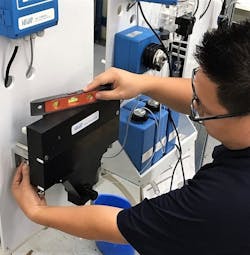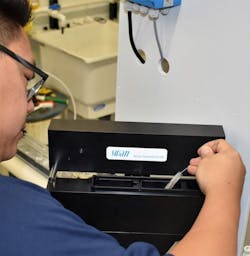About the author:
Robert Reyes is support manager at Swan Analytical USA. Reyes can be reached at
[email protected].
Ensuring that pathogen-free water is provided to customers is one of the most important functions of a water treatment plant. Accurate turbidity measurement is a key component in any water treatment system to ensure pathogen-free water.
An online turbidity instrument will pass light into water flowing through a fixed chamber. While clean water will allow light to pass through, suspended matter will scatter the light. A detector at 90 degrees will see more scattered light in water that has higher concentrations of matter. While not specific for pathogens, it acts as a general indicator.
Turbidity measurement may be useful at a number of steps in a water treatment plant and is an absolute requirement at others. As raw water enters a plant, turbidity measurements may be taken to ensure it can be treated with the system in place. This is especially vital for surface water where particulate and organic constituents may be excessive. Additional turbidity measurements are made throughout the process, most importantly after filtration. At this point, the turbidity measurements are collected and reported to comply with state and federal regulations.
Considerations for Installing Turbidimeters
Most online turbidimeters are designed with a flow-through cell, with samples tapped from a process pipe, diverted through the analyzer and discharged to waste. Installing close to the sample point will reduce lag time in measurements. Ensure that the sample is tapped into the middle of the pipe to reduce the introduction of sediment and air bubbles.
Provide adequate space. Install the turbidimeter where there is room to access the sensor for servicing and cleaning. You will want to ensure that there is adequate room to remove the flow cell cover and to insert a cleaning brush. An analyzer with swing-out capabilities can be useful in tight spaces.
Ensure the sensor is level. If the sensor is not level, the flow cell chamber may not fill correctly, and this could introduce issues to the light path through the sample. If your analyzer comes pre-mounted on a panel, it may have an adjustment screw to make fine adjustments. Use a spirit level while making this adjustment to ensure proper level.
Be mindful of disturbances. Install the turbidimeter away from large equipment that may cause vibration. Vibration of the sample chamber can cause ripples that will produce measurement errors.
Analyze flow conditions. Turbulent flow can introduce air bubbles into the sample stream. While these will not contribute significantly at higher turbidity levels, at levels below 1 nephelometric turbidity unit (NTU) they can be a problem. If it is not possible to sample in a way that eliminates the problem, a degasser will be required. Low flow also can be a problem. In this case, make sure to have have a flowmeter installed prior to the analyzer or select an analyzer with integrated flow measurement. Low-flow alarms can identify false readings until flow issues are resolved.
Cleaning & Maintenance
While flow through a turbidity analyzer will ensure most sediment and particles are flushed through to waste, there will be some that remains in the chamber. Regular cleaning to remove this buildup can be time-consuming. To improve performance between cleanings and to increase the time between required cleanings, consider turbidimeters that offer drain capabilities. Some offer auto-drain functionality that can automatically drain the chamber on a user-selected interval.
To ensure consistent accuracy, periodic cleaning should be scheduled. If the analyzer is a non-contact design, the flow cell and degasser are the primary concerns. In analyzers with optics or optical windows that are in contact with the sample, cleaning those surfaces is important.
To clean the chamber, shut off flow to the analyzer and open the flow chamber. Use an anti-scaling solution and brush to remove particulates and scale buildup. Be sure to thoroughly rinse with deionized water.
If the turbidimeter is a non-contact design, the optics are not subjected to the process water and no cleaning is required; contacting the optics should be avoided. On contacting turbidimeters, the coating of the optics is among the most common sources of error. To clean, use a soft cloth and a mild detergent or alcohol. Do not use a brush on optics or windows, as it can cause scratching. Be sure to rinse thoroughly with deionized water.
If properly installed and maintained, turbidity analyzers will provide reliable, accurate and trouble-free performance.


